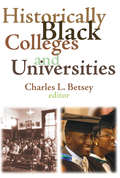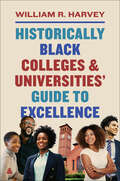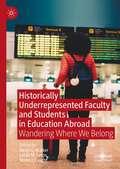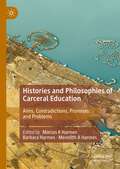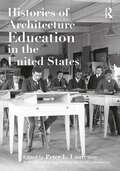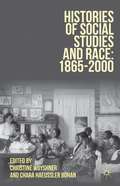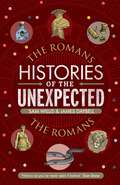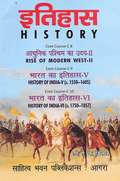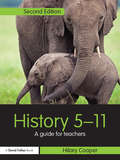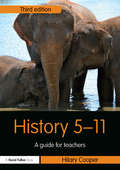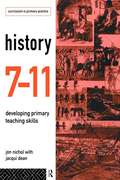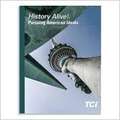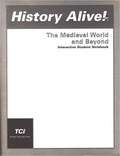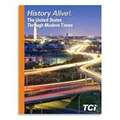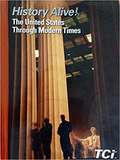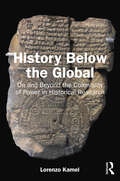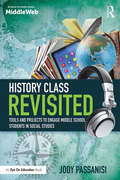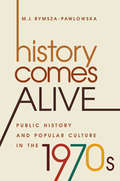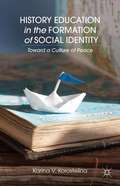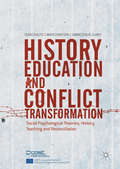- Table View
- List View
Historically Black Colleges and Universities
by Charles L. BetseyBeginning in the 1830s, public and private higher education institutions established to serve African-Americans operated in Pennsylvania and Ohio, the Border States, and the states of the old Confederacy. Until recently the vast majority of people of African descent who received post-secondary education in the United States did so in historically black institutions. Spurred on by financial and accreditation issues, litigation to assure compliance with court decisions, equal higher education opportunity for all citizens, and the role of race in admissions decisions, interest in the role, accomplishments, and future of Historically Black Colleges and Universities has been renewed. This volume touches upon these issues.Historically Black Colleges and Universities (HBCUs) are a diverse group of 105 institutions. They vary in size from several hundred students to over 10,000. Prior to Brown v. Board of Education, 90 percent of African-American postsecondary students were enrolled in HBCUs. Currently the 105 HBCUs account for 3 percent of the nation's educational institutions, but they graduate about one-quarter of African-Americans receiving college degrees. The competition that HBCUs currently face in attracting and educating African-American and other students presents both challenges and opportunities. Despite the fact that numerous studies have found that HBCUs are more effective at retaining and graduating African-American students than predominately white colleges, HBCUs have serious detractors. Perhaps because of the increasing pressures on state governments to assure that public HBCUs receive comparable funding and provide programs that will attract a broader student population, several public HBCUs no longer serve primarily African-American students.There is reason to believe, and it is the opinion of several contributors to this book, that in the changing higher education environment HBCUs will not survive, particularly those that are
Historically Black Colleges and Universities' Guide to Excellence
by Dr. William R. HarveyFrom the esteemed President of Hampton University, an insider account that reveals the secret to HBCU graduates’ remarkable success—a distinguished honor roll which includes Vice President Kamala Harris, Dr. Martin Luther King Jr., Oprah Winfrey, Zora Neale Hurston, Toni Morrison, Ruth Carter, Ta-Nehisi Coates, and many others.In his more-than-four-decade tenure as the President of Hampton University—one of 107 Historically Black Colleges and Universities in America—Dr. William R. Harvey has been a champion of the cultural impact and value of HBCUs, demonstrated by the achievements of their numerous notable alumni. Their success is no coincidence. It is the result of a faultless formula that sets HBCUs apart and helps their students thrive—a formula built on core tenets, including displaying moral and wholesome values at all times, continuously pursuing character growth, and embracing communal responsibilities whenever possible.The mission of Dr. Harvey is to represent Blackness to its highest degree at every opportunity. He is a passionate believer in the remarkability of the Black diaspora in all its complexity and beauty. That conviction drives the timeless lessons he’s adhered to and has instilled in his students: the power of dress to establish respect; the importance of integrity; financial accountability; reverence for elders. It is these tried-and-true lessons and others that have uniquely prepared and propelled HBCU students to success for generations. The Historically Black Colleges and Universities' Guide to Excellence is a thoughtful and knowledgeable account of what it truly takes to successfully navigate a white world as a Black person while retaining one’s core Blackness. Practical and proven, it lays the groundwork for individual and communal Black prosperity.
Historically Underrepresented Faculty and Students in Education Abroad: Wandering Where We Belong
by Devin L. Walker Linda M. Lyons Seneca VaughtThis book examines how the unique perspectives of BIPOC faculty and students must be integrated into the undergraduate curriculum to expose students of color to education abroad experiences, enhance cultural awareness and sensitivity, and lend to a broader diversity and inclusion perspective. This edited volume, written by authors of color, argues that education abroad programs not only provide essential academic and cultural enrichment but can also be an important nexus of innovation. When approached within a creative, interdisciplinary, and holistic framework, these programs are ripe with opportunities to engage various constituencies and a potent source of strategies for bolstering diversity, recruitment, retention, and graduation. Despite a tendency to view study abroad as a luxurious option for persons with wealth and means, the editors and their authors argue that global education should be thought of as a fundamental and integral part of higher education, for all students, in a global era.
Histories and Philosophies of Carceral Education: Aims, Contradictions, Promises and Problems
by Barbara Harmes Marcus K Harmes Meredith A HarmesThis edited collection encourages philosophical exploration of the nature, aims, contradictions, promises and problems of the practice of education within prisons around the world. Such exploration is particularly necessary given the complex operational barriers to education, and higher education in particular, within prison-based teaching and learning. These operational barriers are matched by cultural and polemical barriers, such as the criticism of diverting resources to and spending money on prisoner education when the cost of some education seems prohibitive for people outside prison. More so than in other education contexts, prison education may fall short of higher ideals because it is shot through with both practical and moral-political problems and challenges, especially in the age of global late capitalism, high technology and mass incarceration or securitization. This book includes insights and issues around a wide range of areas including: ethics, religion, sociology, justice, identity and political and moral philosophy.
Histories of Architecture Education in the United States
by Peter L. LaurenceHistories of Architecture Education in the United States is an edited collection focused on the professional evolution, experimental and enduring pedagogical approaches, and leading institutions of American architecture education. Beginning with the emergence of architecture as a profession in Philadelphia and ending with the early work, but unfinished international effort, of making room for women and people of color in positions of leadership in the field, this collection offers an important history of architecture education relevant to audiences both within and outside of the United States. Other themes include the relationship of professional organizations to educational institutions; the legacy of late nineteenth-century design concepts; the role of architectural history; educational changes and trans-Atlantic intellectual exchanges after WWII and the Cold War; the rise of the city and urban design in the architect’s consciousness; student protests and challenges to traditional architecture education; and the controversial appearance of environmental activism. This collection, in other words, provides a relevant history of the present, with topics of concern to all architects studying and working today.
Histories of Heinrich SchüTz
by Bettina VarwigBettina Varwig places the music of the celebrated Dresden composer Heinrich Schütz in a richly detailed tapestry of cultural, political, religious and intellectual contexts. Four key events in Schütz's career – the 1617 Reformation centenary, the performance of his Dafne in 1627, the 1636 funeral composition Musikalische Exequien and the publication of his motet collection Geistliche Chormusik (1648) – are used to explore his music's resonances with broader historical themes, including the effects of the Thirty Years' War, contemporary meanings of classical mythology, Lutheran attitudes to death and the afterlife as well as shifting conceptions of time and history in light of early modern scientific advances. These original seventeenth-century circumstances are treated in counterpoint with Schütz's fascinating later reinvention in nineteenth- and twentieth-century German musical culture, providing a new kind of musicological writing that interweaves layers of historical inquiry from the seventeenth century to the present day.
Histories of Social Studies and Race: 1865–2000
by Christine Woyshner Chara Haeussler BohanIn Histories of Social Studies and Race: 1865-2000, researchers investigate the interplay of race and the emerging social studies field from the time of the Emancipation of enslaved peoples in the second half of the nineteenth century to the multicultural and Afrocentric education initiatives of the late-twentieth century. The chapters incorporate viewpoints from various regions and local communities, as well as different ideas and ideals regarding teaching about race and Black history. This volume makes a case for considering the goals of such efforts - whether for individual development or social justice - and views the teaching of social studies education through the lens of race.
Histories of the Unexpected: The Romans (Histories of the Unexpected)
by Sam Willis James DaybellThe Histories of the Unexpected series not only presents a new way of thinking about the past, but also reveals the world around us as never before. Traditionally, the Romans have been understood in a straightforward way but the period really comes alive if you take an unexpected approach to its history. Yes, emperors, the development of civilization and armies all have a fascinating history . . . but so too do tattoos, collecting, fattening, recycling, walking, poison, fish, inkwells and wicked stepmothers! Each of these subjects is equally fascinating in its own right, and each sheds new light on the traditional subjects and themes that we think we know so well.
History (Core Course 8, Core Course 9 and Core Course 10) B.A (Hons.) Sem-IV -Ranchi University, N.P.U
by A. K. MittalHistory text book According to the Latest Syllabus based on Choice Based Credit System (CBCS) for Sem-IV (Core Course 8,Core Course 9 And Core Course 10) from Ranchi University, Nilambar Pitambar University in hindi.
History - Higher Secondary First Year - Tamil Nadu Board - SCERT
by Government TamilnaduThe subject to be discussed in the lesson is introduced Leads the students to animated audio, video aids for getting experiential learning Provides additional information related to the subject in boxes to stir up the curiosity of students Infographs - Visual representations intended to make the complex simple and make the students grasp difficult concepts easily.
History 11th Standard - Tamilnadu Board
by Training State Council of Educational ResearchHistory Textbook for the 11th Standard Students, preparing for Tamil Nadu State Board Exam.
History 12th Standard - Tamilnadu Board
by Training State Council of Educational ResearchHistory Textbook for the 12th Standard Students, preparing for Tamil Nadu State Board Exam.
History 5-11: A guide for teachers
by Hilary CooperHistory 5-11 addresses the key issues surrounding the teaching of history in the primary curriculum. With an emphasis on the importance of learning about the past through the processes of historical enquiry, this textbook will be an invaluable resource to all trainee and practising primary teachers interested in teaching history in an accessible, dynamic and above all enjoyable way. This fully updated second edition highlights: Examples of good practice; Meaningful assessment and record keeping; Planning for progression and differentiation; The primary to secondary transition; Cross-curricular approaches to history. This book also analyses the most recent and salient reports concerning primary education, including the 2011 Ofsted report History for All, the Historical Association Primary Survey 2011 and the findings of the Cambridge Review. It contains case studies, lesson planning guidance and methods to develop pupils’ historical understanding as well as offering creative and innovative ways to teach the subject of history in the primary classroom.
History 5–11: A Guide for Teachers (Primary 5-11 Series)
by Hilary CooperNow in its third edition, History 5-11 aims to make teaching about the past exciting and stimulating for both teachers and children. Focusing on the English National Curriculum for History (2013), and with an emphasis on the importance of learning about the past through the processes of historical enquiry, History 5-11 contains case studies, lesson planning guidance and methods to develop pupils‘ historical understanding. It offers creative and innovative ways to teach the subject of history, refreshing teachers‘ confidence in teaching the 2013 curriculum, and is illustrated by new case studies and research. This fully updated third edition includes: References to the 2013 National Curriculum, its aims and purposes, and its content and processes for Key Stages 1 & 2 Guidance on making local, national and global connections between societies over time Planning for assessment and progression New research and illustrative case studies New sections on local history and links to oracy Updates to all existing chapters Reflection on practice and research: undergraduate, Masters level and PhD. This textbook is an invaluable resource to all trainee and practising primary teachers interested in teaching history in an accessible, dynamic and above all, enjoyable way.
History 7-11: Developing Primary Teaching Skills
by Jacqui Dean Jon NicholLearning history is remembered by many teachers as a passive process involving 'learning dates'. In this book, the emphasis is on 'doing history' - making sense of the past through the process of investigation as a true historian would. The authors argue that children should be involved in historical investigations, thus developing the skills and processes that underpin historical understanding. Using an Action Research approach to improving practice, the authors' own case-study of 'The Vikings' and teachers' accounts are used to illustrate different teaching approaches. These fully involve the children as historians in an imaginative and creative way. Each chapter is supported by exercises and activities which demonstrate how to translate theory into practice together with a specific focus on the problems of planning and resourcing to produce practical teaching strategies.
History Alive! Pursuing American Ideals
by Diane HartBy using this program, the students will discover how the skills of social sciences are used to explore the history of the United States. The print and online components of this program provide the tools needed for a complete learning cycle. Each unit begins with an online Unit Opener to prepare for inquiry--asking questions and proposing supported answers and solutions. Each lesson with a Lesson Guide preview activity that engages inquiry and sets a foundation for the lesson's content. In the Lesson Guide, student will participate in an interactive activity that connects to both the C3 Framework and English Language Arts and literacy. In these activities, they will use the tools of social studies inquiry: asking questions, using sources and other evidence to develop claims, and communicating conclusions. The lesson concludes as the readers demonstrate their knowledge of the lesson's core ideas and the inquiry process through a variety of paper and online Assessments.
History Alive! The Medieval World and Beyond (History Alive!)
by Teachers' Curriculum InstituteHistory Alive! The Medieval World and Beyond (Interactive Student Notebook)
History Alive! The U.S. Through Modern Times Student Edition
by Frey Diane Wendy HartHistory Alive! The U.S. Through Modern Times Student Edition
History Alive!: The United States Through Modern Times
by Diane Hart Bert Bower Teachers' Curriculum Institute StaffA valuable resource full of imaginative, ready-to-use ideas for social studies teachers who want to involve students of all ability levels in the learning process. History is presented from a multicultural perspective to maximize student awareness.
History Below the Global: On and Beyond the Coloniality of Power in Historical Research
by Lorenzo KamelHistory Below the Global aims to foster an entangled knowledge of global history, and to place "others" at the centre stage, to better understand the fluid world which we inhabit.Relying on primary sources in seven languages and books written by hundreds of African, Asian, Middle Eastern and South American scholars, Lorenzo Kamel examines the coloniality of power in historical research and sheds light on the largely neglected roles of the "others" and their modernities in history. The book provides three elements combined. Firstly, a thorough analysis of the process of accumulation (“knowledge piece by piece”) which underpins some of the major achievements in human history. Secondly, a view on pre-colonial perspectives and the process through which the latter have been swallowed up by Eurocentric and solipsistic perceptions. Lastly, a study of the roots and outcomes of colonialisms and their echoes in our present. These three elements are addressed by combining multiple methodologies and approaches, in the awareness that the history analysed, as well as the historiographical trajectories that underlie it, are ultimately inter-penetrable, as well as themselves the result of a process of accumulation. History Below the Global challenges the view that, first and foremost, the “West”, for bad and for good, is and was the centre: the proactive actor which did and undid.This volume will be of value to all those interested in global history, the history of colonialism, post-colonial studies, modern and contemporary history.
History Class Revisited: Tools and Projects to Engage Middle School Students in Social Studies
by Jody PassanisiLearn new approaches to teaching history in middle school so students are more engaged in the big ideas and eager to examine the world around them. Co-published by Routledge and MiddleWeb, this practical guide will help you consider the unique needs of middle schoolers, who are in the midst of many social and emotional changes and need to see why the study of history matters to their own lives. Author Jody Passanisi shares helpful strategies and activities to make your social studies class a place where students can relate to the material, connect past history to present events, collaborate with others, think critically about important issues, and take ownership of their learning. Topics include: Reading and analyzing primary and secondary sources for deeper comprehension of historical issues Developing a written argument and defending it with supporting details and cited sources Examining the social context of a historical event and tracing the historical underpinnings of present day issues Using field trips, games, and Project Based Learning to make learning history a fun and interactive experience Assessing your students’ progress using self-reflection, projects, essays, and presentations The appendices offer resources for each of the topics covered in the book as well as reproducible Blackline Masters of the charts and diagrams, which can be photocopied or downloaded from our website (http://www.routledge.com/products/9781138639713) for classroom use.
History Comes Alive: Public History and Popular Culture in the 1970s (Studies in United States Culture)
by M. J. Rymsza-PawlowskaDuring the 1976 Bicentennial celebration, millions of Americans engaged with the past in brand-new ways. They became absorbed by historical miniseries like Roots, visited museums with new exhibits that immersed them in the past, propelled works of historical fiction onto the bestseller list, and participated in living history events across the nation. While many of these activities were sparked by the Bicentennial, M. J. Rymsza-Pawlowska shows that, in fact, they were symptomatic of a fundamental shift in Americans' relationship to history during the 1960s and 1970s. For the majority of the twentieth century, Americans thought of the past as foundational to, but separate from, the present, and they learned and thought about history in informational terms. But Rymsza-Pawlowska argues that the popular culture of the 1970s reflected an emerging desire to engage and enact the past on a more emotional level: to consider the feelings and motivations of historic individuals and, most importantly, to use this in reevaluating both the past and the present. This thought-provoking book charts the era's shifting feeling for history, and explores how it serves as a foundation for the experience and practice of history making today.
History Education In The Formation Of Social Identity
by Karina V. KorostelinaIn order to determine how history education can be harnessed to reduce conflict attitudes and intentions and create a culture of peace, this book examines how history curricula and textbooks shape the identities of their students through their portrayals of ingroup and outgroup identity, intergroup boundaries, and value systems.
History Education and Conflict Transformation
by Mario Carretero Charis Psaltis Sabina Čehajić-ClancyThis book is open access under a CC BY 4. 0 license. This volume discusses the effects, models and implications of history teaching in relation to conflict transformation and reconciliation from a social-psychological perspective. Bringing together a mix of established and young researchers and academics, from the fields of psychology, education, and history, the book provides an in-depth exploration of the role of historical narratives, history teaching, history textbooks and the work of civil society organizations in post-conflict societies undergoing reconciliation processes, and reflects on the state of the art at both the international and regional level. As well as dealing with the question of the 'perpetrator-victim' dynamic, the book also focuses on the particular context of transition in and out of cold war in Eastern Europe and the post-conflict settings of Northern Ireland, Israel and Palestine and Cyprus. It is also exploring the pedagogical classroom practices of history teaching and a critical comparison of various possible approaches taken in educational praxis. The book will make compelling reading for students and researchers of education, history, sociology, peace and conflict studies and psychology.
